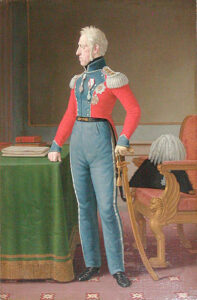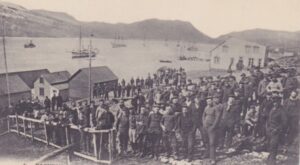Ólöf Júlíana Gunnarsdóttir was born at Yxnatunga in Víðidalur in Húnavatnssýsla on September 25, 1840. She never married but had four children with four different men.
Church records say nothing about her first born, but a preacher´s book in Þingeyrar monastery in September 1863 lists the birth of Jóhann Júlíus Jóhannssonar. Later, one pastor crossed out the surname and, in a footnote wrote: “Later by the mother, a father named Jónas Jónsson, a married man at Hvarf, then drowned”.
This is her adultery, informed the pastor.
And when Ólöf, four years later, gives birth to daughter Ingveldur Jóhanna Jóhannesdóttir, a pastor explains this was the third adultery for the mother but this was the father´s first fornication, who was a married labourer at Kolugil.
Fornication
It is high time to consider what the law had to say on proper sexual behaviour. The term adultery was used for the act of unmarried individuals to have babies who, consequently, were born out of wedlock. Fornication was when a married person was involved. The birth of Ingveldur Jóhanna was a confirmation of her mother’s adultery but the father´s fornication who had cheated on his wife when with Ólöf. The child was labelled illegitimate since she was born out of wedlock.

King Friðrik VI of Denmark 1908-1839.
Around 1800 both Jóhannes (whose last name was Benediktsson) and Ólöf would have been fined for failure of virtue, but Ólöf, after the birth of her 4th child, would have been forced out of this part of the island and placed in another. Jóhannes, if he had been caught the third time for fornication, would have been beheaded. This law dated back to the 16th century but was changed to two years of prison labour by an order issued by the Danish King, July 25, 1808.
This more than anything illustrates radically how times had changed and how lawmakers´ thoughts of sexual conduct evolved through the ages.
The Danish King or his civil servants were somewhat reluctant to address such issues but this was their decision: “The penalty for adultery in Iceland shall from now on be in accordance with existing regulations or law in our other colonies, namely that payments of fines must always take place”.
Fifteen years later (1823) the King yet again saw reasons to lighten penalties for unlawful sexual practises. Sheriffs now had the authority to reduce fines for adultery, even drop them if the spouse of the offender requested that in all earnest.
Another fifteen years pass until lawmakers again are concerned with sexual behaviour of citizens. From Copenhagen, Iceland received an enactment dated January 24, 1838, which included a chapter on adultery and fornication which were not entirely more lenient than the law of 1808, or more severe. Here at long last sexual relationship of unmarried individuals, even though they may result in childbirth shall not be punishable until an individual has been found guilty of such an act on three occasions with different participants. Lawyers may have appreciated this as here they could pardon just about everybody, as how would they interpret “three occasions with different participants”? Did the law permit unmarried couples to have as many children as they liked if they stuck to the same partner?
One fined while another goes free
This question was not an issue for the sheriff in Húnvatnssýsla in the times of Ólöf Júlíana Gunnarsdóttir. Judicial records there contain no evidence the sheriff ever bothered her despite her adultery.
However, a 48-year old maid at Gröf in Húnavatnssýsla, Júliana Gunnlögsdottir, is listed in the records the same year that Ólöf Júlíana gives birth to Ingveldur. Both women have committed the same crime: both were unmarried, mothers of three children and very poor. Júlíana Gunnlögsdóttir stated all her income was used in raising her children, all of whom had died. Her voice trembled a little, as she spoke but she pulled herself together.
The three men, I had them with, likewise, are dead so no support could be expected from them.
In spite of all her efforts to be treated with leniency Sheriff Pétur Havstein fined her nine rigsdaler (the lowest possible fine was eight but highest was fifteen rigsdaler).
The judge in Húnavatnssýsla, Sheriff Pétur Havstein, was somewhat inconsistent according to the above. He fines Júlíana Gunnlögsdóttir but Ólöf Júlíana goes free.
Sister punished – brother goes free – same crime
There are several examples of similar inconsistency in judgements.
In 1866 Markús Ívarsson in Eyjafjörður confessed to fornicating with three different females. That same year his sister Sigríður was in court for exactly the same crime which she explained in court.
Yes, that is correct, she admitted, six years ago I had my first child out of wedlock, the father now deceased. Four years later I had my second, and my third was born last year. Sigríður admitted to her crime, fornication with three different partners and would be fined according to the law. She did not try to hide her crime nor did she make any effort to hold the men accountable but asked the authority for leniency “as she is very poor and unsure if she can look after her children” is stated in the official records.
Sigríður was fined the same amount as Júlíana Gunnlögsdottir, but her brother Markús walked free.
Significant change in 1870
The above must lead the reader to the conclusion that women may have suffered more for promiscuity in the 19th century than men. This research is not complete enough to warrant such conclusion so the topic will be dropped here.
But the fact is that after mid-1870, unmarried individuals in Iceland needed not to worry if they propagated the human race outside of marriage. On August 1, 1870, a new penal legislation for Iceland came into effect in which sexual conduct of unmarried individuals was not mentioned. However, while preparing the new laws, this particular issue was discussed. A committee put together to discuss the new bill pointed out that according to the bill there would be no punishment for three or more fornications. This was actually more lenient than similar laws existing in Denmark. The committee saw no reason to take this further and the Members of Parliament agreed.
Married individuals had to have their urges under control, although no one needed to fear the punishment from the 16th Century which called for beheading of guilty individuals. Those guilty of adultery should be sentenced according to article 160 of the new laws: “Whoever commits adultery shall be imprisoned or, if the marriage is nullified, pay a fine”.
A public inquiry would take place only if the individual cheated on demanded it.
Here the old regulation from 1823 which refers to the forgiveness of the spouse is acknowledged. The guilty party in the marriage no longer had to obtain the forgiveness from authorities to escape fines. Parties involved could forgive and forget and was nobody´s business as long as anger and thirst for revenge would not fill the one cheated on.
It is interesting to note that some Members of Parliament found it too much to give the innocent spouse complete authority to bring the guilty spouse to court. Such breach of moral excellence was so common here in Iceland, they said, that authorities must not release its right to bring adulterers to court. But the lawmakers in Copenhagen were not concerned.
Ratio illegitimate and unmarried
Before ending this piece on sexual conduct in 19th century Iceland, the question is if it gives a wrong idea or an inaccurate picture of our ancestor´s sexual behaviour.
A key source, Hagskinna, lists 14% of live-born children were illegitimate in the whole country in the middle of the 19th Century, but the percentage is up to 20% around 1880. To complete the picture, the percentage in the 21st Century is over 60%.
It is necessary to consider the matrimonial situation of middle-aged Icelanders in 1850. Hagskinna says unmarried females aged 50-54 totalled 387 or 22% of this age group. Males in the same categories were less than half or 12%. Thirty years later in 1880, the ratio of both sexes had risen, unmarried females to 24% while males were 14%. One explanation is the fact the number of females in that age group was higher than that of males. Immune to syphilis or what?
Now a few points regarding promiscuity of the 19th-century Icelanders. In his little booklet on mid-19th-century Iceland, published in 1853, Adolph F. Bergsöe insisted that foreign fishermen usually transmitted syphilis in Iceland.
Despite this fact, wrote Bergsöe, and despite the fact Icelanders are not especially virtuous, the illness had always disappeared after some time.
There were some who argued that Icelanders were immune to this disease but, once it was established that was not the case, a different argument was introduced. The nation lived by very strict but simple moral principles that prevented indecency. Previously-mentioned Dr. Edward Ehlers strongly opposed this theory, saying one only needs to spend one night in a typical main-room (baðstofa) in an Icelandic sod house where all inhabitants on the farm slept in one large heap – and naked – to be convinced. However, Ehlers could not deny the fact that syphilis was extremely rare in Iceland.

French sailors in Fáskrúðsfjörður.
This had nothing to do with moral principles. The isolation of farms, sheltered by tall mountains, prevented traffic from one farm to the next, argued the Danish medical doctor.
At the dawn of the 20th Century nothing had changed. Syphilis was far from being a problem in the country. In view of all this, the conclusion can be made that the 19th-century Icelanders were not as promiscuous as sometimes has been suggested.
The above is based on research by the Icelandic Historian, Jón Hjaltason and his article “Hór og legorð” English version by Thor group.
